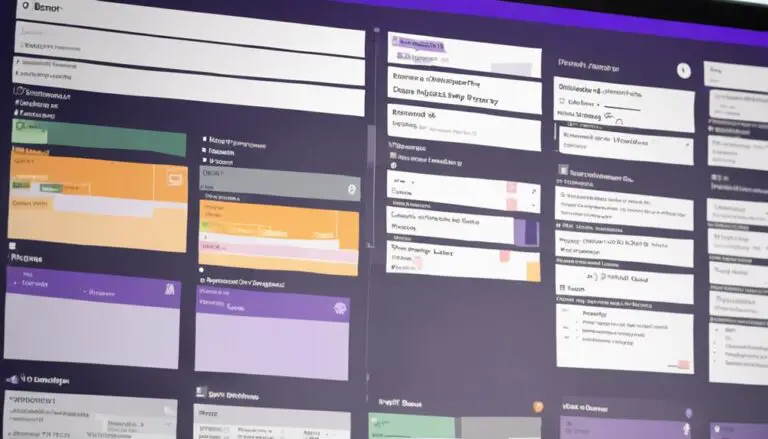Incorporating sprints within Kanban methodology allows for a seamless integration of two powerful approaches to workflow management. Kanban sprint strategies provide the framework for setting specific time-bound goals within the Kanban system, allowing teams to prioritize and focus on key tasks during a set period. By combining the flexibility and continuous flow of work in Kanban with the structured planning and execution of sprints, teams can enjoy the benefits of both methodologies. This integration facilitates improved predictability, transparency, and collaboration, ultimately leading to enhanced productivity and delivery of high-quality work.
By blending the time-boxed focus of sprints with Kanban's emphasis on continuous improvement, teams can achieve a balanced workflow that promotes efficiency and adaptability.
This combination offers a unique perspective on task management that enhances team collaboration and productivity.
Want to discover how this fusion can revolutionize your team's workflow efficiency and drive better results?
Key Takeaways
- Kanban enhances workflow by visualizing tasks and limiting WIP while integrating sprints for focused progress.
- Sprint integration in Kanban improves prioritization, collaboration, tracking, and adaptability for efficient workflow management.
- Task management with Kanban emphasizes visibility, structured dependencies, accurate estimation, and dynamic adaptation to achieve goals.
- Kanban promotes team collaboration, transparency, productivity, and workflow optimization by combining sprints for effective management.
Understanding Kanban Methodology
To truly grasp the essence of Kanban methodology, dive into how it streamlines workflow by visualizing tasks on a Kanban board and limiting work in progress (WIP).
The Kanban board serves as a visual management tool, dividing work into smaller tasks that move through various columns representing different stages of completion. By setting limits on work in progress, teams can focus on completing existing tasks before starting new ones, enhancing efficiency and reducing multitasking distractions.
Flow metrics, such as cycle time and throughput, help teams track the progress of tasks on the board, enabling them to identify bottlenecks and areas for improvement.
Continuous improvement is a core principle of Kanban, encouraging teams to reflect on their processes regularly and make incremental changes to enhance workflow. The simplicity and ease of use of Kanban make it a popular choice for teams looking to streamline their work processes and achieve greater productivity.
Benefits of Sprint Integration
When integrating sprints into Kanban, you'll notice improved task prioritization, allowing for better focus on what matters most.
Enhanced team collaboration becomes a natural outcome, fostering a sense of unity and shared progress.
Real-time progress tracking keeps everyone informed and accountable, ensuring smoother workflow management.
Improved Task Prioritization
Integrating sprints into Kanban enhances task prioritization by providing clear visibility into dependencies and critical paths for efficient workflow management. By incorporating sprint integration, teams can better understand the relationships between tasks, enabling them to focus on crucial activities that drive project progress.
This approach allows for a more structured way to manage task dependencies and ensures that work aligns with project timelines. The combination of sprints with Kanban also aids in improving task estimation accuracy, leading to enhanced planning and delivery.
Through this method, teams can adapt quickly to changing priorities, fostering a dynamic environment that promotes productivity and timely task completion. Embracing sprint integration within Kanban fosters a collaborative atmosphere where individuals feel connected and valued in achieving shared goals.
Enhanced Team Collaboration
Enhancing team collaboration through sprint integration in Kanban fosters a culture of shared ownership and focused task completion, promoting transparency and accountability within the team.
Benefits of Sprint Integration:
- Shared Ownership: Sprint integration encourages team members to collectively take responsibility for tasks, fostering a sense of unity and collaboration.
- Focus on Completing Tasks: By breaking down work into manageable sprints, teams can concentrate on specific goals, enhancing productivity and efficiency.
- Transparency: Kanban's sprint integration provides clear visibility into each team member's progress, promoting open communication and trust among colleagues.
This collaborative approach not only improves teamwork but also empowers individuals to work together towards shared objectives, creating a harmonious and productive work environment.
Real-Time Progress Tracking
Incorporating real-time progress tracking through sprint integration in Kanban enhances team visibility and task monitoring within fixed time frames. By integrating sprints, teams can stay updated on work-in-progress status, promptly address bottlenecks, and align efforts to meet sprint objectives efficiently.
This real-time tracking feature enables quick feedback loops, aiding in making necessary adjustments for improved workflow management. Through sprint integration, Kanban structures tasks effectively, breaking down work into manageable units that promote continuous progress.
Embracing real-time progress tracking within sprints not only fosters collaboration but also instills a sense of achievement as teams work together towards achieving set goals. Stay connected, stay informed, and drive success with Kanban's sprint integration for enhanced productivity.
Implementing Kanban Sprint Planning
To effectively implement Kanban sprint planning, start by aligning tasks with your team's capacity and workflow metrics. Incorporate flow metrics such as WIP limits, cycle time, and throughput to optimize performance.
Here are three key steps to guide you through the process:
- Set Clear WIP Limits: Define the maximum number of work items that can be in progress simultaneously to prevent overburdening your team and ensure smoother workflow.
- Track Cycle Time: Monitor the time it takes for a task to move from start to finish. Analyzing cycle times helps in identifying inefficiencies and streamlining processes.
- Emphasize Task Control: Empower team members to take ownership of their tasks by providing visibility into individual responsibilities and progress. This fosters accountability and enhances collaboration within the team.
Enhancing Workflow Efficiency
Let's start by looking at task prioritization techniques to optimize your workflow efficiency further. By continually refining how you prioritize tasks, you can ensure that your team focuses on high-impact activities.
Embracing continuous workflow improvement will help you adapt to changing priorities and enhance overall efficiency.
Task Prioritization Techniques
Prioritizing tasks in Kanban involves categorizing them based on their importance and impact on workflow efficiency, enhancing overall productivity. To achieve this, consider these key techniques:
- Value Stream Mapping: Identify critical tasks that require immediate attention during sprints for streamlined workflow management.
- Cost of Delay Analysis: Prioritize tasks with significant implications on workflow progress to ensure efficient sprint execution.
- High-Value Work Items Focus: Direct efforts towards delivering high-value work items during sprints to optimize workflow efficiency.
Continuous Workflow Improvement
Enhance your workflow efficiency through continuous improvement techniques in Kanban. Focus on visualizing work progress and setting WIP limits to optimize task management. By incorporating sprints into your workflow, you can identify areas for enhancement and streamline processes effectively.
Utilizing flow-based sprint planning, Kanban enables you to measure performance using metrics like cycle time and throughput, fostering team improvement. Visualizing work progress allows for better transparency and control over tasks, ensuring smoother collaboration and task completion. Implementing WIP limits prevents bottlenecks and maintains focus, ultimately enhancing overall workflow efficiency.
Embrace these continuous workflow improvement methods in Kanban to refine your processes and achieve optimal results in your project management endeavors.
Combining Kanban and Sprints
By combining Kanban and sprints, teams can enhance their workflow management by visualizing tasks on a Kanban board with columns representing workflow stages. This integration offers a powerful way to improve task visibility, limit work in progress (WIP), and deliver specific increments of work within defined time frames.
Key Points:
- Task Visibility: Kanban boards provide a clear visual representation of tasks, helping teams track progress and identify bottlenecks easily.
- WIP Limitation: Setting WIP limits ensures that team members focus on completing tasks before taking on new work, promoting efficiency and reducing multitasking.
- Time-Bound Increments: Sprints within Kanban allow teams to work towards a sprint goal within a fixed timeframe, fostering a sense of achievement and progress.
Streamlining Processes With Kanban
To streamline processes effectively with Kanban, focus on optimizing task flow and visual management techniques. Kanban's approach integrates seamlessly with sprints, emphasizing continuous improvement of workflow efficiency.
By utilizing flow metrics such as WIP limits and cycle time, teams can enhance their process management within the sprint framework. The visual Kanban board serves as a central tool for streamlining tasks and monitoring work progress in real-time, enabling better coordination and transparency.
Integrating Kanban with sprints not only boosts productivity but also nurtures team collaboration, communication, and task control. Through tracking progress and forecasting using flow metrics, Kanban ensures that workflow management remains optimized and aligned with sprint goals.
Embracing Kanban principles alongside sprint practices empowers teams to adapt quickly, visualize their workflow, and continuously refine their processes for maximum efficiency. By leveraging Kanban's visual cues and flow metrics, teams can achieve smoother workflows and better results within their sprints.
Achieving Better Results Together
Let's join forces to maximize our collective efforts and achieve better results together. When it comes to combining Kanban with sprints, teamwork plays a crucial role in elevating workflow efficiency and achieving outstanding outcomes.
Here are three key ways to enhance collaboration and productivity:
- Team Collaboration: Emphasize working together seamlessly, sharing knowledge, and supporting one another to achieve common goals.
- Visualizing Work Progress: Utilize Kanban boards to visualize tasks, track progress, and ensure transparency within the team.
- Continual Process Improvement: Encourage a culture of continuous enhancement by regularly reviewing processes, seeking feedback, and implementing necessary adjustments.
Optimizing Workflow Management
For streamlining your workflow management effectively, consider leveraging the synergies between Kanban and Sprints to optimize task allocation and completion. By combining Kanban's visual workflow management with Sprint planning, you empower your team to enhance collaboration and productivity.
The visual aspect of Kanban boards allows for a clear overview of tasks, fostering transparency and shared understanding among team members. Tracking flow metrics such as cycle time and throughput within Sprints enables you to identify bottlenecks and inefficiencies, leading to quicker task completion and improved overall workflow.
Through this integration, you create a structured approach that ensures tasks move smoothly from start to finish, promoting a sense of accomplishment and momentum within the team. Embracing this methodology not only streamlines task delivery but also cultivates a culture of continuous improvement and efficiency in your workflow management practices.
Key Strategies for Effective Implementation
Considering the synergies between Kanban and Sprints, implementing key strategies effectively can significantly enhance your workflow management practices. Here are three essential strategies to ensure successful implementation:
- Set Clear WIP Limits: Establishing Work In Progress (WIP) limits on your Kanban board is crucial for maintaining focus during sprints. By limiting the number of tasks in progress, you can prevent bottlenecks and ensure a smooth workflow.
- Enhance Task Visibility: Improve transparency by making all tasks visible on the Kanban board. This increased visibility fosters better team collaboration, as everyone can easily track progress, identify dependencies, and prioritize tasks effectively.
- Monitor Cycle Time: Keep a close eye on cycle time, which measures how long it takes for a task to move from start to finish. By analyzing cycle time data, you can identify inefficiencies, optimize processes, and enhance overall workflow management within sprints.
Implementing these strategies won't only streamline your workflow but also boost team productivity and collaboration.
Frequently Asked Questions
How Does Kanban Work With Sprints?
When using Kanban with sprints, you'll find that sprint planning, task prioritization, daily stand-ups, work in progress limits, and cycle time tracking are key. It's about optimizing workflow, boosting collaboration, and achieving project goals efficiently.
How Do I Manage Sprints in Kanban Board?
Hey, managing sprints on a Kanban board? Start by organizing tasks in columns: backlog, sprint commitments, active work, completed work. Use swimlanes or colors for sprint clarity. Sync planning meetings with board updates for aligned goals.
What Is an Effective Workflow for Kanban?
To optimize workflow in Kanban, prioritize tasks, improve continuously, collaborate with your team, and use visual management. This approach ensures efficient task progression, balanced workloads, and streamlined processes for maximum productivity.
What Is the Sprint Goal in Kanban?
To nail the sprint goal in Kanban, team up for sprint planning, hit sprint duration, review progress, dive into retrospectives, and manage that sprint backlog. Keep it collaborative, stay adaptive, and rock that common purpose!
Conclusion
Congratulations! By incorporating sprints into your Kanban workflow, you have taken a big step towards optimizing your team's efficiency and productivity.
Remember, 'teamwork makes the dream work!' Keep collaborating, adapting, and iterating to achieve even better results in your workflow management.
With the right strategies in place, you're well on your way to success! Keep up the great work!





